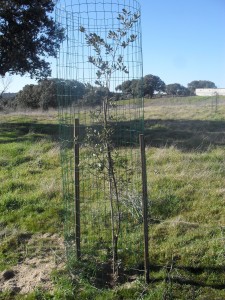The improvement of the age structure of aged stands through repopulation and individual protection, with plantations with a density next to the regenerated one of 200 plants/ha, with 1-2 saps forest tree. The main species planted is holm oak Quercus ilex spp. ballota (80%) and the accompanying species are Quercus pyrenaica (10%), hawthorn Crataegus monogyna (5%), and wild pear Pyrus bourgaeana (5%). Protectors are placed on 30% of trees at risk from wild or domestic herbivores.
In holm oak woods and pastures, improvements are made to the phytosanitary condition of the trees so that they can develop by pruning and highlighting those holm oak woods that have sprouted again and have dense formations. Dry branches are removed from adult trees and individual protection is provided for standing trees in cattle areas.
Since its creation, ATN has been developing ecological restoration and management of forest areas (reforestation and recovery of areas burned by fires) in ecologically important habitats. For the last 5 years it has had an active forest fire surveillance programme.
The University of Salamanca will study, with LIFE, mycological bioindicators that determine the health of the pasture, establishing correlations between the presence of certain species of fungi and the state of conservation of the ecosystems. We start to design the sampling work from the map of vegetation and use, and establish a selection of sites according to the type of plant species present and the type of intensity of human activity. Mycological inventories are carried out at these points in autumn and spring, analysing the relationships obtained between the presence or absence of certain species and the state of conservation of the habitat.



Comments are closed.